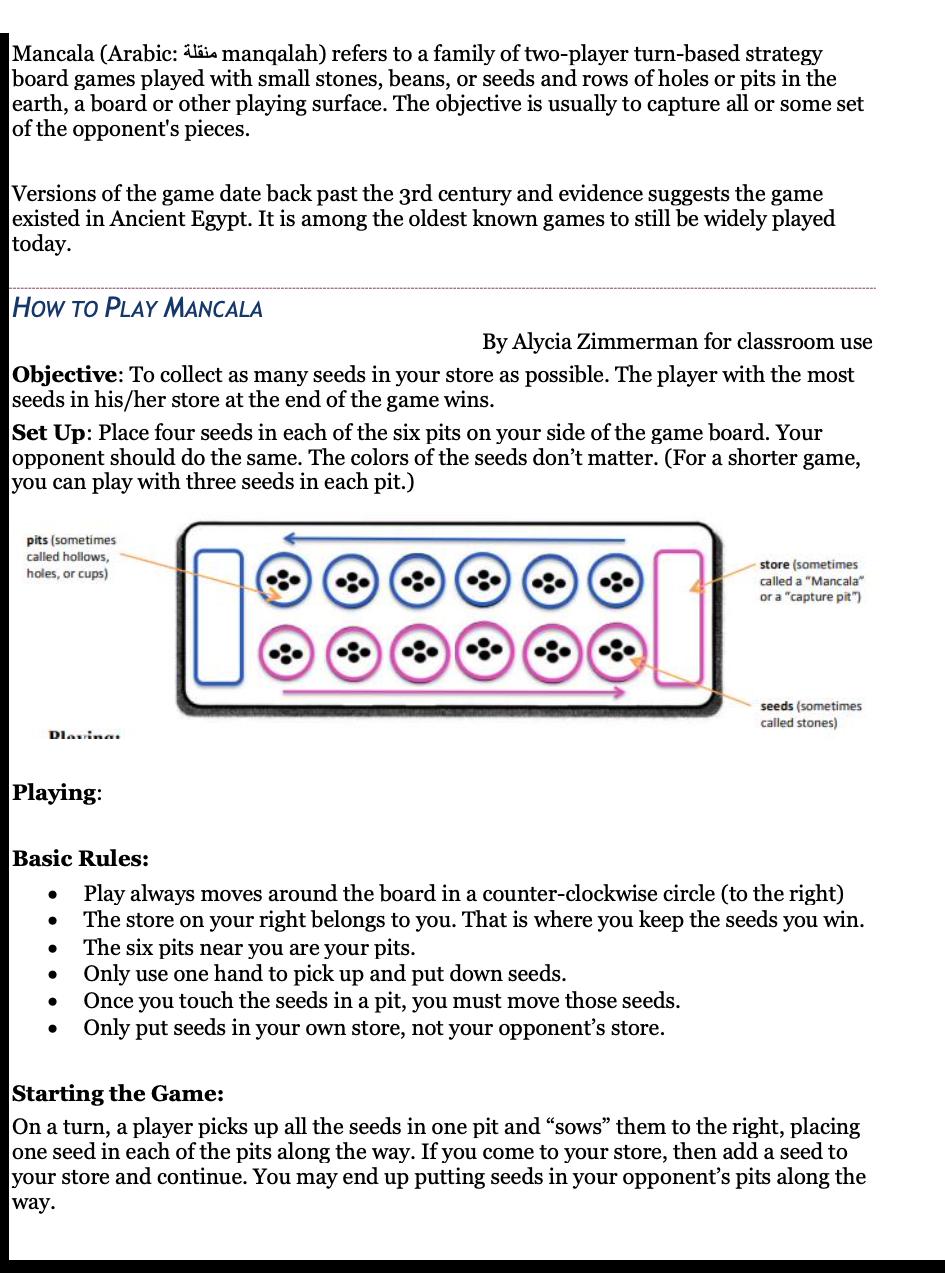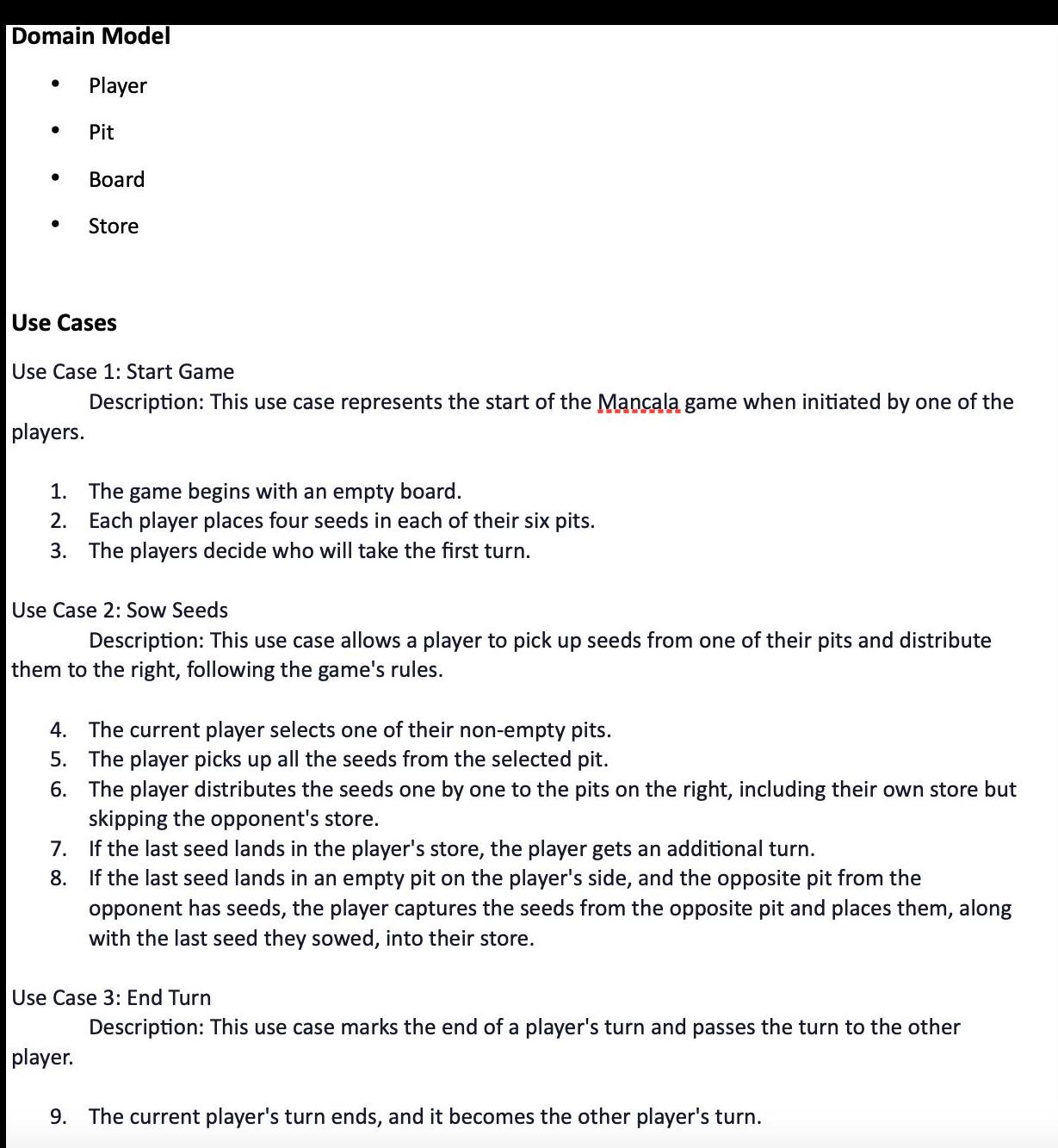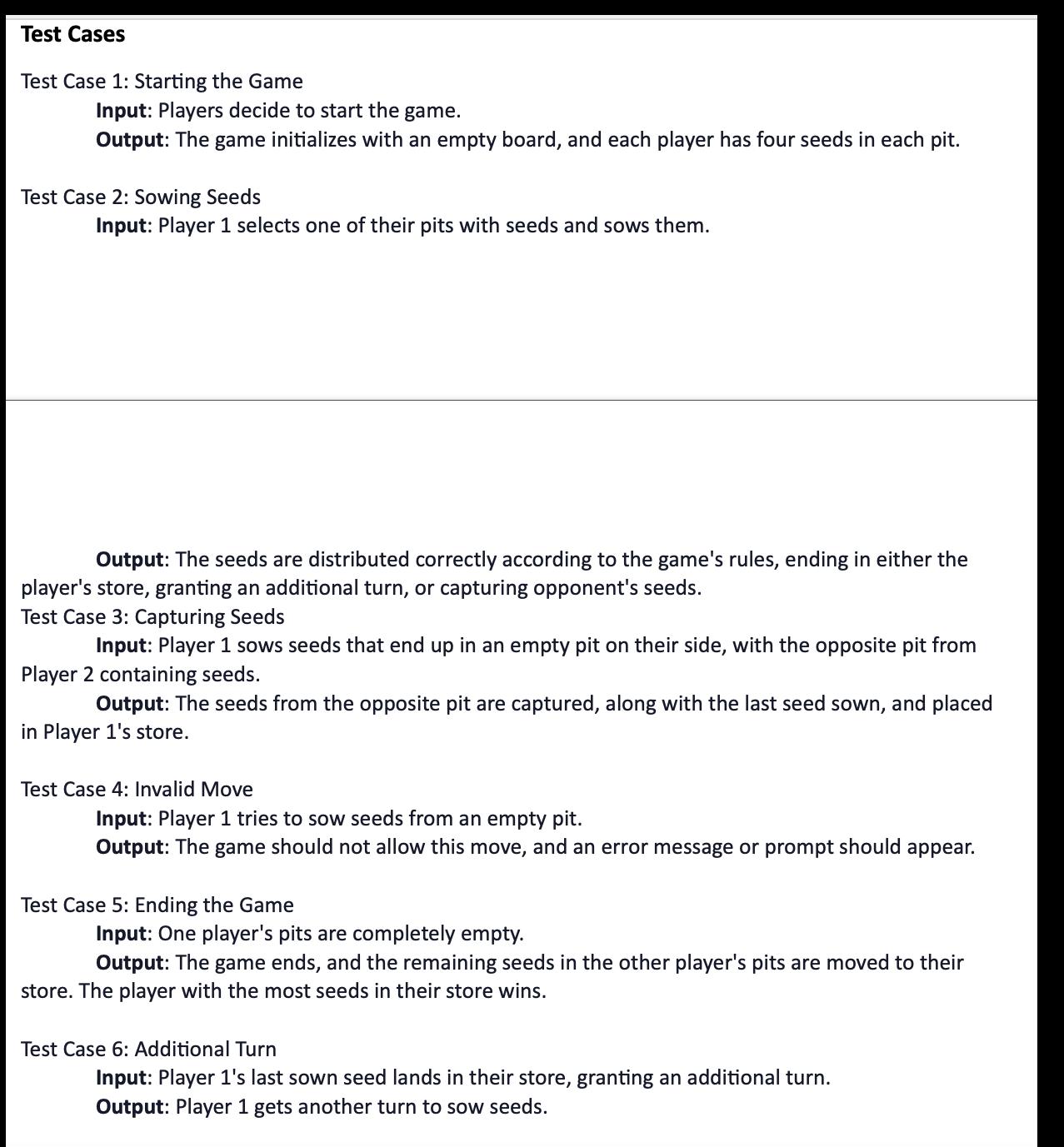Answered step by step
Verified Expert Solution
Question
1 Approved Answer
Mancala (Arabic: manqalah) refers to a family of two-player turn-based strategy board games played with small stones, beans, or seeds and rows of holes




Mancala (Arabic: manqalah) refers to a family of two-player turn-based strategy board games played with small stones, beans, or seeds and rows of holes or pits in the earth, a board or other playing surface. The objective is usually to capture all or some set of the opponent's pieces. Versions of the game date back past the 3rd century and evidence suggests the game existed in Ancient Egypt. It is among the oldest known games to still be widely played today. HOW TO PLAY MANCALA By Alycia Zimmerman for classroom use Objective: To collect as many seeds in your store as possible. The player with the most seeds in his/her store at the end of the game wins. Set Up: Place four seeds in each of the six pits on your side of the game board. Your opponent should do the same. The colors of the seeds don't matter. (For a shorter game, you can play with three seeds in each pit.) pits (sometimes called hollows, holes, or cups) Dlavina Playing: 8 store (sometimes called a "Mancala" or a "capture pit") Basic Rules: Play always moves around the board in a counter-clockwise circle (to the right) The store on your right belongs to you. That is where you keep the seeds you win. The six pits near you are your pits. Only use one hand to pick up and put down seeds. Once you touch the seeds in a pit, you must move those seeds. Only put seeds in your own store, not your opponent's store. seeds (sometimes called stones) Starting the Game: On a turn, a player picks up all the seeds in one pit and "sows" them to the right, placing one seed in each of the pits along the way. If you come to your store, then add a seed to your store and continue. You may end up putting seeds in your opponent's pits along the way. O Figure 1 On the game board above, the pink player (bottom row) just made his first move of the game. He picked up all of the seeds from the third pit and placed one seed in each of the pits to the right. The final seed in his hand landed in his store, so he now gets to take another turn. : Play alternates back and forth, with opponents picking up the seeds in one of their pits and distributing them one at a time into the pits on the right, beginning in the pit immediately to the right. Special Rules: When the last seed in your hand lands in your store, take another turn. When the last seed in your hand lands in one of your own pits, if that pit had been empty you get to keep all of the seeds in your opponents pit on the opposite side. Put those captured seeds, as well as the last seed that you just played on your side, into the store. Ending the Game: The game is over when one player's pits are completely empty. The other player takes the seeds remaining in her pits and puts those seeds in her store. Count up the seeds. Whoever has the most seeds wins. ASSIGNMENT 5A: Create a document with a domain model; Use Case Diagram; Use Cases, and Robustness Diagram; draft test cases 5B Revised Documents above; Working game model; test cases I will try to create a web-interface to the game model. Since we haven't defined a common API we may need to create an adapter-interface to connect to your game. More news to come! Domain Model Player Pit Board Store Use Cases Use Case 1: Start Game Description: This use case represents the start of the Mancala game when initiated by one of the players. 1. The game begins with an empty board. 2. Each player places four seeds in each of their six pits. 3. The players decide who will take the first turn. Use Case 2: Sow Seeds Description: This use case allows a player to pick up seeds from one of their pits and distribute them to the right, following the game's rules. player. 4. The current player selects one of their non-empty pits. 5. The player picks up all the seeds from the selected pit. 6. The player distributes the seeds one by one to the pits on the right, including their own store but skipping the opponent's store. 7. If the last seed lands in the player's store, the player gets an additional turn. 8. If the last seed lands in an empty pit on the player's side, and the opposite pit from the opponent has seeds, the player captures the seeds from the opposite pit and places them, along with the last seed they sowed, into their store. Use Case 3: End Turn Description: This use case marks the end of a player's turn and passes the turn to the other 9. The current player's turn ends, and it becomes the other player's turn. Test Cases Test Case 1: Starting the Game Input: Players decide to start the game. Output: The game initializes with an empty board, and each player has four seeds in each pit. Test Case 2: Sowing Seeds Input: Player 1 selects one of their pits with seeds and sows them. Output: The seeds are distributed correctly according to the game's rules, ending in either the player's store, granting an additional turn, or capturing opponent's seeds. Test Case 3: Capturing Seeds Input: Player 1 sows seeds that end up in an empty pit on their side, with the opposite pit from Player 2 containing seeds. Output: The seeds from the opposite pit are captured, along with the last seed sown, and placed in Player 1's store. Test Case 4: Invalid Move Input: Player 1 tries to sow seeds from an empty pit. Output: The game should not allow this move, and an error message or prompt should appear. Test Case 5: Ending the Game Input: One player's pits are completely empty. Output: The game ends, and the remaining seeds in the other player's pits are moved to their store. The player with the most seeds in their store wins. Test Case 6: Additional Turn Input: Player 1's last sown seed lands in their store, granting an additional turn. Output: Player 1 gets another turn to sow seeds. Mancala (Arabic: manqalah) refers to a family of two-player turn-based strategy board games played with small stones, beans, or seeds and rows of holes or pits in the earth, a board or other playing surface. The objective is usually to capture all or some set of the opponent's pieces. Versions of the game date back past the 3rd century and evidence suggests the game existed in Ancient Egypt. It is among the oldest known games to still be widely played today. HOW TO PLAY MANCALA By Alycia Zimmerman for classroom use Objective: To collect as many seeds in your store as possible. The player with the most seeds in his/her store at the end of the game wins. Set Up: Place four seeds in each of the six pits on your side of the game board. Your opponent should do the same. The colors of the seeds don't matter. (For a shorter game, you can play with three seeds in each pit.) pits (sometimes called hollows, holes, or cups) Dlavina Playing: 8 store (sometimes called a "Mancala" or a "capture pit") Basic Rules: Play always moves around the board in a counter-clockwise circle (to the right) The store on your right belongs to you. That is where you keep the seeds you win. The six pits near you are your pits. Only use one hand to pick up and put down seeds. Once you touch the seeds in a pit, you must move those seeds. Only put seeds in your own store, not your opponent's store. seeds (sometimes called stones) Starting the Game: On a turn, a player picks up all the seeds in one pit and "sows" them to the right, placing one seed in each of the pits along the way. If you come to your store, then add a seed to your store and continue. You may end up putting seeds in your opponent's pits along the way. O Figure 1 On the game board above, the pink player (bottom row) just made his first move of the game. He picked up all of the seeds from the third pit and placed one seed in each of the pits to the right. The final seed in his hand landed in his store, so he now gets to take another turn. : Play alternates back and forth, with opponents picking up the seeds in one of their pits and distributing them one at a time into the pits on the right, beginning in the pit immediately to the right. Special Rules: When the last seed in your hand lands in your store, take another turn. When the last seed in your hand lands in one of your own pits, if that pit had been empty you get to keep all of the seeds in your opponents pit on the opposite side. Put those captured seeds, as well as the last seed that you just played on your side, into the store. Ending the Game: The game is over when one player's pits are completely empty. The other player takes the seeds remaining in her pits and puts those seeds in her store. Count up the seeds. Whoever has the most seeds wins. ASSIGNMENT 5A: Create a document with a domain model; Use Case Diagram; Use Cases, and Robustness Diagram; draft test cases 5B Revised Documents above; Working game model; test cases I will try to create a web-interface to the game model. Since we haven't defined a common API we may need to create an adapter-interface to connect to your game. More news to come! Domain Model Player Pit Board Store Use Cases Use Case 1: Start Game Description: This use case represents the start of the Mancala game when initiated by one of the players. 1. The game begins with an empty board. 2. Each player places four seeds in each of their six pits. 3. The players decide who will take the first turn. Use Case 2: Sow Seeds Description: This use case allows a player to pick up seeds from one of their pits and distribute them to the right, following the game's rules. player. 4. The current player selects one of their non-empty pits. 5. The player picks up all the seeds from the selected pit. 6. The player distributes the seeds one by one to the pits on the right, including their own store but skipping the opponent's store. 7. If the last seed lands in the player's store, the player gets an additional turn. 8. If the last seed lands in an empty pit on the player's side, and the opposite pit from the opponent has seeds, the player captures the seeds from the opposite pit and places them, along with the last seed they sowed, into their store. Use Case 3: End Turn Description: This use case marks the end of a player's turn and passes the turn to the other 9. The current player's turn ends, and it becomes the other player's turn. Test Cases Test Case 1: Starting the Game Input: Players decide to start the game. Output: The game initializes with an empty board, and each player has four seeds in each pit. Test Case 2: Sowing Seeds Input: Player 1 selects one of their pits with seeds and sows them. Output: The seeds are distributed correctly according to the game's rules, ending in either the player's store, granting an additional turn, or capturing opponent's seeds. Test Case 3: Capturing Seeds Input: Player 1 sows seeds that end up in an empty pit on their side, with the opposite pit from Player 2 containing seeds. Output: The seeds from the opposite pit are captured, along with the last seed sown, and placed in Player 1's store. Test Case 4: Invalid Move Input: Player 1 tries to sow seeds from an empty pit. Output: The game should not allow this move, and an error message or prompt should appear. Test Case 5: Ending the Game Input: One player's pits are completely empty. Output: The game ends, and the remaining seeds in the other player's pits are moved to their store. The player with the most seeds in their store wins. Test Case 6: Additional Turn Input: Player 1's last sown seed lands in their store, granting an additional turn. Output: Player 1 gets another turn to sow seeds. Mancala (Arabic: Almanqalah) refers to a family of two-player turn-based strategy board games played with small stones, beans, or seeds and rows of holes or pits in the earth, a board or other playing surface. The objective is usually to capture all or some set of the opponent's pieces. Versions of the game date back past the 3rd century and evidence suggests the game existed in Ancient Egypt. It is among the oldest known games to still be widely played today. HOW TO PLAY MANCALA By Alycia Zimmerman for classroom use Objective: To collect as many seeds in your store as possible. The player with the most seeds in his/her store at the end of the game wins. Set Up: Place four seeds in each of the six pits on your side of the game board. Your opponent should do the same. The colors of the seeds don't matter. (For a shorter game, you can play with three seeds in each pit.) pits (sometimes called hollows, holes, or cups) Dlavina Playing: 8 store (sometimes called a "Mancala" or a "capture pit") Basic Rules: Play always moves around the board in a counter-clockwise circle (to the right) The store on your right belongs to you. That is where you keep the seeds you win. The six pits near you are your pits. Only use one hand to pick up and put down seeds. Once you touch the seeds in a pit, you must move those seeds. Only put seeds in your own store, not your opponent's store. seeds (sometimes called stones) Starting the Game: On a turn, a player picks up all the seeds in one pit and "sows" them to the right, placing one seed in each of the pits along the way. If you come to your store, then add a seed to your store and continue. You may end up putting seeds in your opponent's pits along the way. O Figure 1 On the game board above, the pink player (bottom row) just made his first move of the game. He picked up all of the seeds from the third pit and placed one seed in each of the pits to the right. The final seed in his hand landed in his store, so he now gets to take another turn. : Play alternates back and forth, with opponents picking up the seeds in one of their pits and distributing them one at a time into the pits on the right, beginning in the pit immediately to the right. Special Rules: When the last seed in your hand lands in your store, take another turn. When the last seed in your hand lands in one of your own pits, if that pit had been empty you get to keep all of the seeds in your opponents pit on the opposite side. Put those captured seeds, as well as the last seed that you just played on your side, into the store. Ending the Game: The game is over when one player's pits are completely empty. The other player takes the seeds remaining in her pits and puts those seeds in her store. Count up the seeds. Whoever has the most seeds wins. ASSIGNMENT 5A: Create a document with a domain model; Use Case Diagram; Use Cases, and Robustness Diagram; draft test cases 5B Revised Documents above; Working game model; test cases I will try to create a web-interface to the game model. Since we haven't defined a common API we may need to create an adapter-interface to connect to your game. More news to come! Domain Model Player Pit Board Store Use Cases Use Case 1: Start Game Description: This use case represents the start of the Mancala game when initiated by one of the players. 1. The game begins with an empty board. 2. Each player places four seeds in each of their six pits. 3. The players decide who will take the first turn. Use Case 2: Sow Seeds Description: This use case allows a player to pick up seeds from one of their pits and distribute them to the right, following the game's rules. player. 4. The current player selects one of their non-empty pits. 5. The player picks up all the seeds from the selected pit. 6. The player distributes the seeds one by one to the pits on the right, including their own store but skipping the opponent's store. 7. If the last seed lands in the player's store, the player gets an additional turn. 8. If the last seed lands in an empty pit on the player's side, and the opposite pit from the opponent has seeds, the player captures the seeds from the opposite pit and places them, along with the last seed they sowed, into their store. Use Case 3: End Turn Description: This use case marks the end of a player's turn and passes the turn to the other 9. The current player's turn ends, and it becomes the other player's turn. Test Cases Test Case 1: Starting the Game Input: Players decide to start the game. Output: The game initializes with an empty board, and each player has four seeds in each pit. Test Case 2: Sowing Seeds Input: Player 1 selects one of their pits with seeds and sows them. Output: The seeds are distributed correctly according to the game's rules, ending in either the player's store, granting an additional turn, or capturing opponent's seeds. Test Case 3: Capturing Seeds Input: Player 1 sows seeds that end up in an empty pit on their side, with the opposite pit from Player 2 containing seeds. Output: The seeds from the opposite pit are captured, along with the last seed sown, and placed in Player 1's store. Test Case 4: Invalid Move Input: Player 1 tries to sow seeds from an empty pit. Output: The game should not allow this move, and an error message or prompt should appear. Test Case 5: Ending the Game Input: One player's pits are completely empty. Output: The game ends, and the remaining seeds in the other player's pits are moved to their store. The player with the most seeds in their store wins. Test Case 6: Additional Turn Input: Player 1's last sown seed lands in their store, granting an additional turn. Output: Player 1 gets another turn to sow seeds.
Step by Step Solution
★★★★★
3.36 Rating (146 Votes )
There are 3 Steps involved in it
Step: 1
Answer The best possible move in th...
Get Instant Access to Expert-Tailored Solutions
See step-by-step solutions with expert insights and AI powered tools for academic success
Step: 2

Step: 3

Ace Your Homework with AI
Get the answers you need in no time with our AI-driven, step-by-step assistance
Get Started


